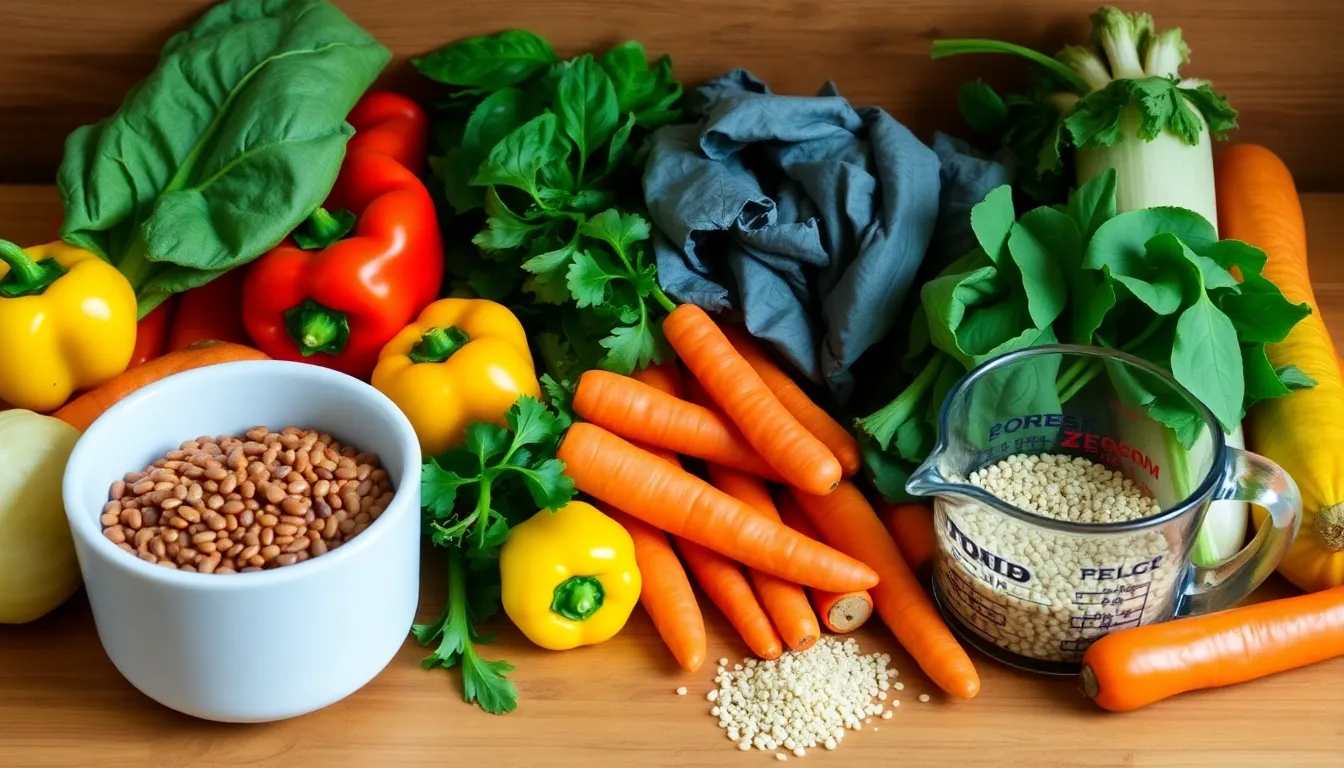Imagine coming home after a long day, greeted by the mouthwatering aroma of a delicious meal waiting for you. No, it’s not a mirage; it’s the magic of a crockpot! With just a bit of prep in the morning, you can whip up healthy recipes that’ll make your taste buds dance and your waistline thank you.
Table of Contents
ToggleBenefits Of Using A Crockpot
Crockpots offer numerous advantages that simplify meal preparation and promote healthy eating. They allow individuals to enjoy nutritious meals without spending hours in the kitchen.
Time-Saving Convenience
Preparation time becomes minimal with a crockpot. Users can add ingredients in the morning, set the desired temperature, and leave for the day. Meals cook slowly throughout the day, ensuring they are ready upon return. This efficiency reduces stress and eliminates the need for last-minute cooking after a busy day. Meal planning grows easier as well, promoting healthier eating habits through pre-prepared dishes.
Healthy Cooking Methods
Healthy cooking methods feature prominently with crockpot usage. Slow cooking retains nutrients within vegetables and proteins, making meals flavorful and nutritious. Many recipes require less oil compared to traditional frying, fostering lower calorie intake. Utilizing fresh, whole ingredients supports a balanced diet and enhances overall health. The versatility of a crockpot accommodates various diets, including vegetarian, gluten-free, and low-carb options, allowing for tailored meals that meet individual dietary needs.
Essential Ingredients For Crockpot Healthy Recipes

Selecting the right ingredients enhances the nutritional value of crockpot meals. Consider the following essential components for balanced crockpot recipes.
Lean Proteins
Lean proteins serve as a foundation for healthy crockpot meals. Chicken breast, turkey, and fish provide essential amino acids while keeping fat content low. Plant-based options like lentils and chickpeas also offer significant protein, making them ideal for vegetarian recipes. Combining these proteins with vegetables boosts fiber content, promoting satiety and overall health. Incorporating different flavors, such as herbs and spices, elevates their taste while maintaining a nutritious profile.
Vegetables and Legumes
Vegetables and legumes add vital nutrients to crockpot dishes. Carrots, bell peppers, and spinach contribute essential vitamins and minerals. Legumes, including beans and peas, deliver protein and fiber, enhancing heart health and digestion. Selecting seasonal vegetables ensures freshness and maximum flavor. Mixing various colors not only appeals visually but also increases the range of nutrients. Ensuring a variety of textures and tastes makes each meal inviting and satisfying.
Whole Grains and Healthy Fats
Whole grains provide energy and fiber in crockpot recipes. Brown rice, quinoa, and farro are excellent options, offering longer-lasting fuel for daily activities. Healthy fats, like olive oil and avocado, support heart health and nutrient absorption. Including these fats in moderation balances meals and enhances flavors. Opting for whole grains over refined options maximizes nutritional benefits while keeping dishes hearty and enjoyable.
By incorporating these essential ingredients, crockpot recipes become not only practical but also nourishing and delightful.
Popular Crockpot Healthy Recipes
Crockpots offer a variety of healthy meal options. Popular recipes include low-calorie soups, nutrient-dense stews, and flavorful dishes.
Low-Calorie Soups
Low-calorie soups provide warmth and nutrition. Ingredients like tomatoes, spinach, and zucchini form a wholesome base. Chicken broth or vegetable stock enhances the flavor while keeping calories in check. Adding beans boosts protein and fiber content. Lemon juice or fresh herbs can brighten up the taste without adding calories. Recipes may include minestrone or vegetable lentil soup.
Nutrient-Dense Stews
Nutrient-dense stews bring together a variety of ingredients for balanced meals. Lean meats such as chicken or turkey work well with an array of vegetables. Carrots, sweet potatoes, and root vegetables deliver vitamins and minerals. Adding legumes enhances protein while keeping the dish hearty. Using spices such as thyme or paprika can elevate flavors without extra calories. Examples include beef stew and vegetable quinoa stew.
Flavorful Healthy Dishes
Flavorful healthy dishes showcase the versatility of crockpot cooking. Ingredients like whole grains, lean proteins, and vibrant vegetables create satisfying meals. For instance, a chickpea curry can be both rich in flavor and high in fiber. Incorporating herbs and spices transforms simple ingredients into exciting meals. Rotating recipes, such as salsa chicken or lentil and vegetable chili, keeps meals engaging. Using fresh ingredients ensures nutrient retention and maximizes flavor.
Tips For Making Healthy Crockpot Meals
Planning and prepping meals ahead makes healthy eating simple and straightforward. Organizing ingredients the night before can streamline morning routines, allowing users to focus on their day. Portions also play a role; preparing larger batches ensures balanced meals throughout the week. Consider using freezer-safe bags for extra convenience. Chop vegetables and measure spices in advance to save time. Select recipes that utilize seasonal produce to enhance flavor and cut costs.
Meal Prep and Planning
Meal prepping and planning take the guesswork out of weeknight dinners. Start by selecting a few recipes that include a variety of proteins, grains, and vegetables. Incorporating lean protein options like chicken and plant-based sources like lentils diversifies nutritional benefits. Create a shopping list based on the selected recipes, minimizing waste and adhering to budget constraints. Batch cooking helps maximize time; cooking larger quantities allows for easy leftovers. Store portions in the fridge for quick reheating or in the freezer for longer preservation.
Adjusting Seasonings and Flavors
Adjusting seasonings and flavors is key to creating delicious meals in a crockpot. Start by adding spices early in the cooking process to deepen flavors. Fresh herbs like basil and parsley brighten dishes; include them towards the end to maintain freshness. Adjust salt gradually, tasting as ingredients cook to ensure the perfect balance. Acidic components like lemon juice enhance flavor, so consider drizzling some before serving. Experiment with different spice blends to discover personalized combinations, allowing for varied meals that remain healthy and satisfying.
Embracing the use of a crockpot transforms meal preparation into a stress-free experience. With minimal effort in the morning, it’s easy to enjoy healthy, home-cooked meals by dinner time. The versatility of crockpots allows for a range of dietary preferences, ensuring everyone can find something delicious.
By focusing on essential ingredients and smart meal planning, individuals can create nourishing dishes that don’t compromise on flavor. The combination of nutrient retention and low-calorie options makes crockpot cooking a smart choice for those looking to maintain a healthy lifestyle.
With these tips and recipes, it’s simple to make wholesome eating a part of everyday life.


